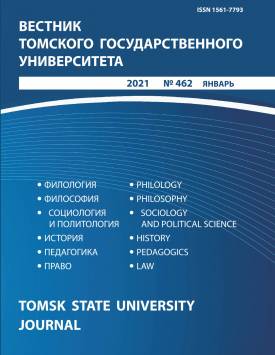Coercive Measures of Educational Influence in the Current Development of Legislation in Juvenile Delinquency Prevention
The article examines the effectiveness of existing criminal legal instruments of educational influence on minors. On the basis of the analysis of strategic planning documents affecting children, changes in criminal and other federal legislation on the basis of the system for the prevention of juvenile neglect and delinquency, it is concluded that the task of bringing the legislation in question in line with international standards has not yet been solved. Criminal legislation in this area is not impeccable and needs to be finalized. Judicial statistics show a low demand for warning as an educational measure. At the same time, criminal legislation does not regulate a specific form of warning and does not answer the question of what negative consequences for a minor may occur if they have not made appropriate conclusions from the declared warning, but have not yet committed a new crime. In addition, the question of the element of coercion in the structure of this measure is raised, and the difficulties of its application are indicated, taking into account the existence in criminal law of rules on the insignificance of the act. It is proposed to remove warning from the list of compulsory measures of educational influence. Based on the analysis of the practice of implementing the obligation to make amends for the harm caused, it is concluded that the coercive element in the structure of this measure is conditional in cases when compensation is paid not by minors themselves, but by their parents. In this part, the measure in question seems ineffective. When considering the provisions governing the transfer of a minor to the surveillance of parents or other persons replacing them, attention is drawn to the absence of the types and limits of surveillance and control clearly defined in the law. In addition, it is concluded that there is a conflict that arises between the rules of criminal procedure law, which provides for negative consequences from failure to comply with the measure imposed on minors, and the provisions of criminal law, according to which the duties are imposed not on the minor, but on third parties. In the light of judicial statistics showing that it is extremely rare for minors to be sentenced to imprisonment for crimes of moderate gravity, the relevance of the provisions of the criminal law providing for the possibility of placing minors who have committed crimes in this category in a special educational facility of a closed type is questioned.
Keywords
juvenile justice,
exemption from criminal liability,
coercive measures of educational influence,
prevention,
transfer to parental surveillanceAuthors
| Laptev Dmitry B. | West Siberian Branch of the Russian State University of Justice | lapa612@mail.ru |
Всего: 1
References
Состояние преступности в России // МВД России. URL: https://xn--b1aew.xn--p1ai/folder/101762 (дата обращения: 04.02.2019).
Национальная стратегия действий в интересах детей на 2012-2017 годы : утв. указом Президента РФ от 01.06.2012 № 761 // Собрание законодательства РФ. 2012. № 23. Ст. 2994.
Об основах системы профилактики безнадзорности и правонарушений несовершеннолетних : Федер. закон от 24.06.1999 № 120-ФЗ [принят Гос. Думой 21.05.1999] (по сост. на 27.06.2018) // КонсультантПлюс: СПС.
Мельникова Э. Б. Ювенальная юстиция. Проблемы уголовного права, уголовного процесса и криминологии. М. : Дело, 2001. 272 с.
Шестакова Л.А. Реализация концепции ювенальной юстиции в производстве по делам несовершеннолетних в Российской Федерации. М. : Юрлитинформ, 2016. 280 с.
Ювенальная юстиция в Российской Федерации: криминологические проблемы развития / отв. ред. Н.П. Мелешко. СПб. : Юридический центр Пресс, 2006. 787 с.
Трунцевский Ю.В. Понятие, содержание и виды мер уголовно-правового и административного воздействия // Административное и муниципальное право. 2015. № 6. С. 554-562.
Биктимеров Э.Л. Иные меры уголовно-правового характера и их роль в осуществлении задач уголовного права России : дис. … канд. юрид. наук. Саратов, 2009. 206 с.
Постановление Пленума Верховного Суда РФ от 29.11.2016 № 56 «О внесении изменений в некоторые постановления Пленума Верховного Суда Российской Федерации по вопросам совершенствования оснований и порядка освобождения от уголовной ответственности» // Российская газета. 2016. 7 декабря.
Бурлака С.А. Принудительные меры воспитательного воздействия в системе мер предупреждения преступлений несовершеннолетних // Вестник Белгородского юридического института МВД России. 2010. № 1. С. 27-31.
Ерофеева В.А. Присмотр за несовершеннолетним подозреваемым, обвиняемым в уголовном судопроизводстве : дис. … канд. юрид. наук. М., 2018. 242 с.
Бахвалова Л.А. Актуальные проблемы эффективности системы мер уголовно-правового воздействия, применяемых в отношении несовершеннолетних // Вестник Омского университета. Серия: Право. 2012. № 2. С. 245-253.
Благов Е.В. Об освобождении от уголовной ответственности несовершеннолетних с применением принудительных мер воспитательного воздействия // Юридическая наука. 2017. № 4. С. 127-132.
Терентьева В.А., Черненко Т.Г. Освобождение несовершеннолетних от уголовного наказания на основании ст. 92 УК РФ // Пробелы в российском законодательстве. 2017. № 2. С. 118-120.
Корягина С.А. Практика применения принудительных мер воспитательного воздействия (по материалам Иркутской области) // Криминологический журнал Байкальского национального университета экономики и права. 2014. № 1. С. 93-97.
Середин А.А. Принудительные меры воспитательного воздействия, применяемые к несовершеннолетним при освобождении от уголовной ответственности : дис. … канд. юрид. наук. М., 2005. 203 с.
Беляева Л.И. Международные стандарты в области правосудия в отношении несовершеннолетних и ювенальная юстиция в России // Вестник института: преступление, наказание, исправление. 2008. № 4. С. 38-44.
Отчет об осужденных, совершивших преступления в несовершеннолетнем возрасте, за 12 месяцев 2019 года // Судебный департамент при Верховном Суде РФ. URL: http://www.cdep.ru/index.php?id=79&item=4572 (дата обращения: 05.07.2020).
Постановление Пленума Верховного Суда РФ от 01.02.2011 № 1 «О судебной практике применения законодательства, регламентирующего особенности уголовной ответственности и наказания несовершеннолетних» // Российская газета. 2011. 11 февраля.
Рабец А.М. Ювенальное право Российской Федерации. М. : Юрайт, 2018. 362 с.

